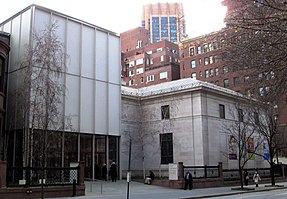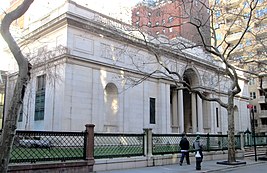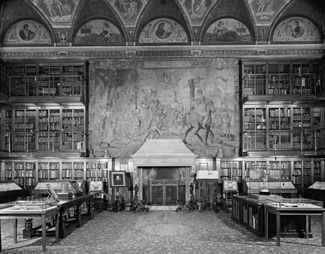Let us go first to Wikipedia...
From Wikipedia, the free encyclopedia
J. Pierpont Morgan Library
|
|
 |
|
(2006)
|
|
| Location: | 225 Madison Avenue at East 36th Street Manhattan, New York City |
|---|---|
| Coordinates: 40°44′55.69″N 73°58′53.6″W | |
| Built: | 1900–06[2] |
| Architect: | Charles Follen McKim[3] |
| Architectural style: | Palladian |
| Governing body: | Private |
| NRHP Reference#: | 66000544[1] |
| Significant dates | |
| Added to NRHP: | November 13, 1966[1] |
| Designated NHL: | November 13, 1966[4] |
| Designated NYCL: | May 17, 1966 |
The building was designated a New York City landmark in 1966,[5] and was declared a National Historic Landmark later that same year.[4][6][7]
Collection

The Renzo Piano-designed entrance building (2006,left) and the Benjamin Wistar Morris-designed annex building (1928,right).
It also contains a large collection of incunabula, prints, and drawings of European artists—Leonardo, Michelangelo, Raphael, Rembrandt, Rubens, Gainsborough, Dürer, and Picasso, early printed Bibles, amongst them, three Gutenberg Bibles, and many examples of fine bookbinding. Other holdings include material from ancient Egypt and medieval liturgical objects (including Coptic literature examples),[8] Emile Zola, William Blake's original drawings for his edition of the Book of Job; concept drawings for The Little Prince by Antoine de Saint-Exupéry; a Percy Bysshe Shelley notebook; originals of poems by Robert Burns; a Charles Dickens manuscript of A Christmas Carol; a journal by Henry David Thoreau; an extraordinary collection of autographed and annotated libretti and scores from Beethoven, Brahms, Chopin, Mahler and Verdi, and Mozart's Haffner Symphony in D Major; and manuscripts of George Sand, William Makepeace Thackeray, Lord Byron, Charlotte Brontë and nine of Sir Walter Scott's novels, including Ivanhoe. The collection still includes a few Old Master paintings collected by Morgan between 1907 and 1911 (works by Hans Memling, Perugino, and Cima da Conegliano), but this has never been the collection's focus, and Ghirlandaio's masterpiece Portrait of Giovanna Tornabuoni was sold to Thyssen when the Great Depression worsened the Morgan family's finances.[9]
Other notable artists of the Morgan Library and Museum are Jean de Brunhoff, Paul Cézanne, Vincent van Gogh, John Leech, Gaston Phoebus, Rembrandt van Rijn, and John Ruskin.[10]
The Morgan has one of the world's greatest collections of ancient Near Eastern cylinder seals, small stone cylinders finely engraved with images for transfer to clay by rolling.[11] It also contains many music manuscripts and a considerable collection of Victoriana, including one of the most important collections of Gilbert and Sullivan manuscripts and related artifacts.[12] Of interest to Australians is a copy of the letter written by Andrea Corsali from India in 1516. This letter, one of five in existence,contains the first description of the Southern Cross which is also illustrated by Corsali in this letter and which was also named 'croce' by him.One other copy of letter is in the British Museum and two are in Australia. The fifth is in the Libray of Princeton University. The letter is also readily available in Ramusio's 'Viaggi' a compendium of letteres of exploration, published in venice in three volumes from 1555 on.
Architecture
The first building constructed to house Morgan's library – the "McKim Building" – was designed in the Classical Revival style by Charles Follen McKim of the noted firm of McKim, Mead & White in 1903. It is located at 33 East 36th Street, which was at the time just to the east of Morgan's residence, a brownstone house at 219 Madison Avenue built in 1880. McKim took his inspiration from the Villa Giulia and its Nymphaeum.[5] The building was constructed from 1902-1907 and has a facade of Tennessee marble and a Palladian arch entrance which features two lions sculpted by Edward Clark Potter, who would later create the two lions that guard the New York Public Library's main building.[5][13] Also in the entrance are roundels and panels by Andrew O'Connor and Adolph Weinman.[5]The interior of the building is richly decorated, with a polychrome rotunda which leads to three public rooms, which were originally Morgan's private study, the librarian's office, and the library itself.[13] The rotunda itself has a domed ceiling with murals and plasterwork inspired by Raphael, created by H. Siddons Mowbray. Morgan's study, now the West Library, has been called "one of the greatest achievements of American interior decoration," while the East Library features triple-tiers of bookcases.[5]
Morgan's residence was torn down in 1928, after his death, to be replaced by an annex building which featured an exhibition hall and a reading room, designed by Benjamin Wistar Morris to harmonize with McKim's original.[5]
The remaining Italianate brownstone house in the library complex is 231 Madison Avenue, on the corner of East 37th Street. This house was built by Phelps, Dodge and Company in 1852 and purchased by J. P. Morgan in 1904. It served as the home of his heir J. P. Morgan Jr. from 1905 to 1943.[3]
2006 renovation
The most recent addition to the library is a modernist entrance building designed by Italian architect Renzo Piano – his New York City debut – and Beyer Blinder Belle, which was completed in 2006.[5] Although externally "bland", the building helps to organize the interior spaces of the complex.[3]The Library was closed during the construction and expansion. In the interim it sponsored numerous traveling exhibitions around the country. When the work was completed, it reopened on April 29, 2006 as the Morgan Library & Museum. With the expansion above and below street level, the Morgan's exhibition space had been doubled; Piano set its new reading room under a translucent roof structure, to allow scholars to examine manuscripts in natural light. Piano's four-story steel-and-glass atrium links McKim's library building and the Morgan house in a new ensemble. Added storage facilities were obtained by drilling into Manhattan's bedrock schist.
In popular culture
- Some of E. L. Doctorow's Ragtime is set in the newly renovated Morgan Library.
- In the Broadway musical Ragtime the library is the location for the final scenes of the show.
And now on to what Yelp has to say, if anything--oh, one of them tells you to "watch out for the Gutenberg Bibles!!"
The Morgan Library & Museum
90 reviews
Rating Details
225 Madison Ave
(between 36th St & 37th St)
New York, NY 10016
Neighborhoods: Midtown East, Murray Hill
(212) 685-0008
(between 36th St & 37th St)
New York, NY 10016
Neighborhoods: Midtown East, Murray Hill
(212) 685-0008
- Nearest Transit Station:
-
33 St (4, 6, 6X)Grand Central - 42 St (S)Grand Central - 42 St (4, 5, 6, 6X)
- Hours:
- Tue-Thu 10:30 am - 5 pmFri 10:30 am - 9 pmSat 10 am - 6 pmSun 11 am - 6 pm
- Good for Kids:
- No
90 reviews for The Morgan Library & Museum
Review Highlights What's this?
-
"Don't miss the Gutenberg Bibles (yes, in the plural) on display." In 12 reviews
-
"My favorite section was the part with the manuscripts." In 21 reviews
-
"A requisite stop for anyone who likes books or design." In 28 reviews
Rating Distribution | Trend

90 reviews in English
-
Review from Mike S.
- Elite '13
- 66 friends
Can't speak for the museum or library, but the dining room was great. Took a client out to lunch last Friday and had a very good experience.
First off, the service was very attentive. Maybe it's because I'm not used to going to fancy restaurants, but I was impressed with how often our waiter came over to check on us - he found the delicate balance between being too overbearing and not caring (I know, I rhymed, does that mean I win the rap game?) -- and make sure that everything was okay.
I ordered the soup of the day to start -- a black bean soup with roasted red pepper aioli, which was terrific and filling on its own -- followed by the Pierrepont Salad. The salad is perfect, loaded with grilled chicken, bacon and a mountain of cheddar cubes in a honey dijon dressing. I never thought I'd say a salad was too much food, but I couldn't finish the damn thing. There are few things more emasculating than ordering a salad, but not being able to finish said salad? I think that counts as an eighth deadly sin.
It sucks that I don't know when I'll be back here next; I really can't see myself coming back unless its for another work lunch. If you're in the area and are looking for a nice, quiet, upscale lunch, definitely stop in. -
Review from Takeharu K.
funniki ga saikou!
NY no kensonn kara hanarete ochituite shokuji ga dekimasita.
chi-zu rizottuto to hanbaga wo tanonda.
ryouhoutomo oishikatttusa.
Good restrant!!! -
Review from MissFroy H.
The new-ish renovation has made this into a soaring, airy space. The room that contains J.P. Morgan's "library" remains unchanged. The book room is still a trip.
On my most recent visit, overheard a tourist explain that the Guttenberg bible was created several hundred years BC. I am not making this up.
So that was fun.
The restaurant is quite good: fairly quiet, at least at lunch. -
Review from Nicki L.
- Elite '13
- 29 friends
This is a small but lovely museum - the architectural style looks very open and clean.
My favorite part of the museum was simply Pierpont Morgan's private library, his study, the rotunda, and the east and west rooms. I really enjoyed looking at the opulence of the decorations.
I also really liked the clear glass elevator - very cool! -
Review from David G.
- Elite '13
- 20 friends
Getting to see Pierpont Morgan's study and library was an amazing experience. Seriously, that along with rotunda area between the two is worth the price of admission. Ol' Pierpont put together quite the collection of historical books, letters and documents, many of which are on display.
I also enjoyed the exhibition on surrealism in the gallery. We only had a few hours before they closed to take it all in which was perfect because this place is pretty small. -
Review from Ran L.
As a small museum. Its design combines modern and history all together fluently. The Potter exhibition is on. Very cute I would say. I went there for Morgan's studies, however, the pictured letter exhibition surprised me. The food there is quite famous, yet the dinning room closes very early and serves lunch only.
The only thing it can improve is that I believe they do more exhibition than they currently are doing and the admission can be a little cheaper. -
Review from David P.
There are days when access to the library is free which is pretty cool! Also, original author copy of "Catcher and the Rye" ! How cool is that?! For library it was very cool. To add the lady who worked there showed us a secrey stairway behind one of the book case try to find it guys! Ok.... stop going to dork out over a library. But take it from me.... for a library it's pretty cool! Try it out on one the free days.
I should also mention, that there are usually couple exhibits (art) in there as well. -
Review from Jeannie B.
It's funny they say the place is not good for kids, yet they treat their patrons like one.
I was told by security that I wasn't allowed to hold my jacket. That I should tie it around my waist or wear it. And that was just as soon as I walked in the exhibit. Def. not interested in a place that doesn't know how to handle the public in a more professional manner. -
Review from Lisa Jane C.
- Elite '13
- 174 friends
Returned last night for my first visit in almost six months, and it was a fabulous experience. Some truly can't-miss exhibits here and Friday nights are the perfect time to visit for reasons which will be detailed later.
Churchill: The Power of Words - is a huge and impressive exhibit on one of the most important figures of the twentieth century. It's divided into several sections (beginning with The Child and ending with The Twilight Years) and displays include everything from a report card to his Nobel Prize for Literature, complete with presentation box. Correspondents range from his parents to President Eisenhower. Two interactive displays are here, giving more information about the exhibits, and broadcasts of his speeches with captions are in a small room. Closes on September 23, 2012.
Renaissance Venice: Drawings From the Morgan has over seventy art and printed matter pieces form the fifteenth and sixteenth centuries. Some of the works are beautiful and featured artists include Titian, Tintoretta, and Veronese. Also displayed are some stunningly illustrated bibles and books by Saint Augustine and Aristotle. Closes on September 23, 2012.
Robert Wilson/ Philip Glass: Einstein on the Beach - is in a room with Wilson's original storyboards on the left and Glass's score on the right. The storyboards are small but detailed, and the autographed manuscript is amazing - the man can write some perfect musical symbols. Rehearsal pieces from early productions are shown in the space in between. Einstein on the Beach: The Changing Image of Opera - is screened in another room. Closes November 04, 2012.
Ellsworth Kelly: Sculpture - has a few totemic forms which are beautifully crafted. Smaller pieces and his notes are also featured. Closes September 09, 2012.
Josef Albers in America: Painting on Paper - has dozens of his works, most relating to "Homage to the Square." It's a great way to see how color, layering and shape can change an artwork. Many of the works have dazzling colors, and are beautiful. My favorites were from the Studies for Variant/Adobe. Closes October 14, 2012.
Restrooms are downstairs. The Morgan has an elevator.
Oh, and why is Friday night the perfect time to visit? Well, admission is free between seven and nine p.m. Patrons must check backpacks and the like, but let's face it, nobody wants to be hit with a shopping bag. Just keep this in mind if you are bringing a laptop.
Last night, a cellist and violinist were playing classical music while people watched while drinking wine and other beverages - yes, this place has a cafe, although I don't know prices. Some couples appeared to be on a date....well, why not?
Would happily return to this one, especially on a Friday night.











No comments:
Post a Comment
Please leave a comment-- or suggestions, particularly of topics and places you'd like to see covered